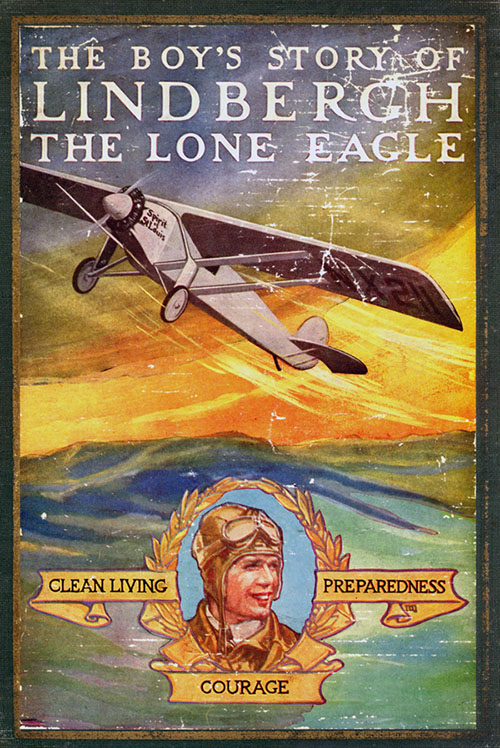Lindbergh and Nungesser
Today, Lindbergh, Nungesser, and their stories. The University of Houston's College of Engineering presents this series about the machines that make our civilization run, and the people whose ingenuity created them.
Just months after Lindbergh flew the Atlantic in 1927, a book appeared: The Boy's Story of Lindbergh. It was pure undistilled hero worship, but it's also oddly revealing. We can learn much from a raw, written-too-quickly book. It can be a useful historic document.
Here is the Lindbergh that a nation needed to see. The words Clean Living, Preparedness, and Courage are placed on the front page. This book is about what people wanted young boys to become. That, in itself, reveals a lot about America eighty years ago. It also describes the event in completely contemporary terms.
Example: A supposed conversation between Lindbergh and Sir Alan Cobham at Le Brouget Airport just after the landing. Cobham was the British long-distance flyer who'd flown around Africa, and from England to Australia. Now he questions Lindbergh about his nonstop flight. First question: "Did you steer by dead-reckoning?"
To do that, a pilot had to know his present location, speed, direction, and the wind velocity. Then he had to plot a course without corrective information. Very tricky. Lindbergh said, Yes, he had. He described his state-of-the-art compass, and explained that he didn't have two hands free to use a sextant. Cobham also asked how he stayed awake and what he ate during 33-1/2 hours.
The conversation explains the flight to us -- helps us understand just why it was no walk in the park. Then the paparazzi journalists ask: What do you suppose has become of Nungesser and Coli?
 Charles Nungesser was a top French air ace in WW-I. After the war, he kept flying. Howard Hawks' epic 1930 movie Dawn Patrol includes footage of Nungesser in the air, made four years earlier.
Charles Nungesser was a top French air ace in WW-I. After the war, he kept flying. Howard Hawks' epic 1930 movie Dawn Patrol includes footage of Nungesser in the air, made four years earlier.
Twelve days before Lindbergh flew, Nungesser and a navigator, François Coli, set out from Paris in a large biplane they called L'Oiseau Blanc -- The White Bird. They meant to make the much harder flight from Paris to New York against the prevailing winds, and they'd disappeared. Lindbergh says he hopes they're okay but doubts it. The great threat in flying the North Atlantic is ice forming on the wings. Once ice gets a footing, it adds a huge load and messes up the airfoil shape. The plane can only go down.
Well, they never were found, but, years later, an engine that could've belonged to The White Bird turned up in the Maine woods. Perhaps they did not die at sea. I recommend a wonderful 1999 movie Dead Aviators [It also goes by the name Restless Spirits] for your kids. Two children meet the ghosts of Nungesser and Coli in the woods. They help them rebuild their ruined airplane so it can fly off to its final resting place.
So there is reality and there is story telling -- there is the real Lindbergh and Nungesser, and there is their story. Historians are responsible for getting the facts right. But story-tellers also have responsibility. They must plumb the meaning of the story -- two roles, two purposes, each meaningless without the other.
I'm John Lienhard, at the University of Houston, where we're interested in the way inventive minds work.
R. J. Beamish, The Boy's Story of Lindbergh, The Lone Eagle. (Chicago: The John C. Winston Co., 1928).
For more on Cobham, Nungesser, and Nungesser's airplane, see
https://en.wikipedia.org/wiki/Alan_Cobham
https://en.wikipedia.org/wiki/Charles_Nungesser
http://www.check-six.com/lib/Famous_Missing/White_Bird.htm
